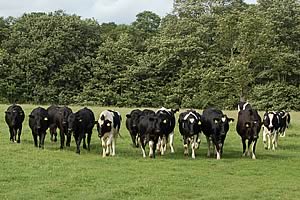| 04/04/07
Around 70% of unvaccinated UK herds continue to show evidence of
leptospirosis infection, according to 2006 test results released
by the Bovine Leptospirosis Information & Screening Service (BLiSS).
Since the launch of the BLiSS initiative in 1999, Schering-Plough
Animal Health has monitored the levels of leptospirosis infection
in the national dairy and beef herd based on laboratory analysis
of milk and blood samples. In 2006 69% of bulk milk samples tested
positive for antibodies to the disease. In addition, 77% of BLiSS
blood samples submitted last year indicated exposure to leptospirosis
infection.
But whilst laboratory analysis of milk and blood samples is undoubtedly
a practical and cost-effective diagnostic tool for assessing
the overall extent of leptospirosis infection, vets warn that
the current technique will not pinpoint the particular strain
of the disease threatening an individual herd.
“Unfortunately, routine testing of bulk milk and herd blood
samples does not distinguish between the two L.hardjo strains – hardjo-bovis
and hardjo-prajitno – that are known to affect cattle in
the UK,” cautions Schering-Plough Animal Health livestock
veterinary adviser Andrew Montgomery MRCVS.
“We know from research that two strains infect cattle in the UK – with
prajitno being more commonly isolated from animals showing severe clinical
signs of leptospirosis: for example, those with severe milk drop or aborting.
However, routine testing cannot identify the actual strains on an individual
farm. Consequently, when it comes to implementing an effective vaccination
programme it's important to use Leptavoid-H, which is the only vaccine
that provides protection against both strains of the disease,” he stresses.
Andrew Montgomery says leptospirosis is one of those insidious,
costly livestock diseases that commonly results in a grumbling
fertility problem in unvaccinated herds. “A series of independent
studies has clearly proved the link between the disease and depressed
conception rates and this is a significant drain on profits. For
example, for every day leptospirosis potentially causes calving
index to slip over 365 it's been estimated that it costs
you at least £2.50 per day. So when you consider you only
need to stop as little as a two day slippage to make a return on
vaccination, it's an investment well worth making,” he
says.
He points out that herds most at risk from leptospirosis are those
that buy stock in; those that use a bull and not AI; those where
cattle co-graze with sheep; and those that graze near watercourses. “So
unless you operate a truly closed herd, it is important to talk
to your vet about testing for leptospirosis and vaccination,” he
advises.
Spring turnout is the key risk period for leptospirosis transmission.
At grass, uninfected cattle are suddenly exposed to the urine of
any infected animals that may be shedding leptospires. Moist spring
grass is also a relatively favourable environment for leptospires,
allowing them to survive for longer outside the host.
Cattle producers can easily screen their herd for infection, Schering-Plough
says. Milk and blood sample diagnostic support is available from
participating vet practices. In addition, if milk producers are
sending milk samples to NMR for fat, protein and cell count analysis,
they can easily ask their laboratory to screen for leptospirosis
as well using the NMR Healthcheck service, the company points out.
 RABDF/Defra
Farm Health Planning Award launched RABDF/Defra
Farm Health Planning Award launched
 Cattle
Industry urged to be vigilant in keeping Bluetongue out Cattle
Industry urged to be vigilant in keeping Bluetongue out
 Semex's
Solution to Finding the Perfect Mate Semex's
Solution to Finding the Perfect Mate |


